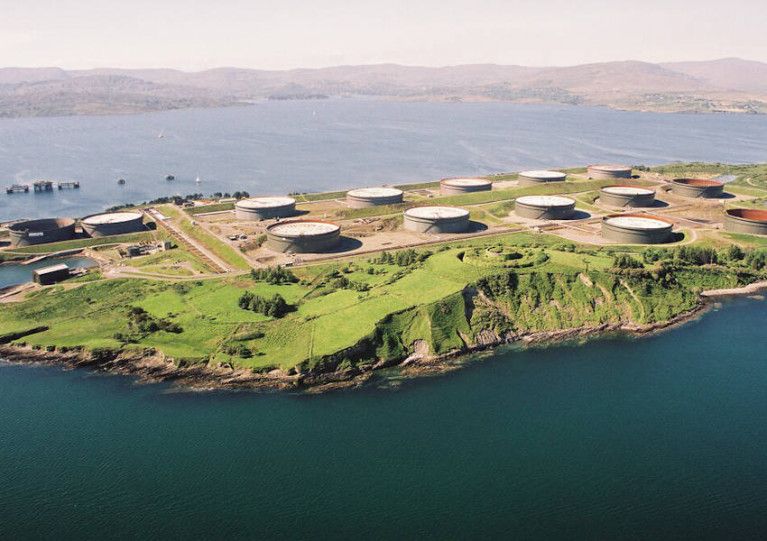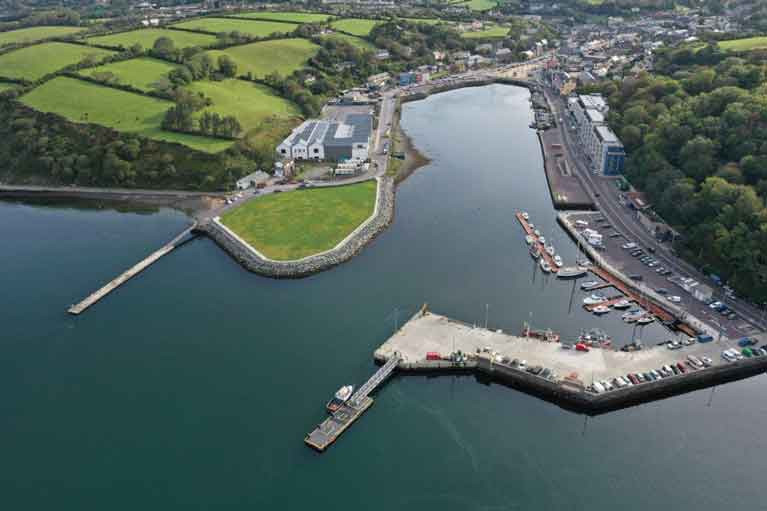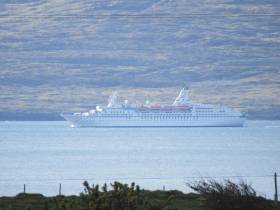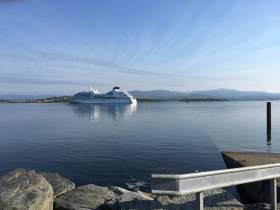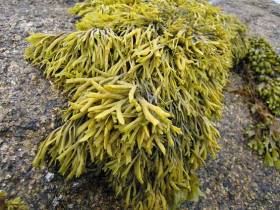Displaying items by tag: Bantry Bay
Blackwater Divers Photograph Shipwreck in Bantry Bay That Lay Undiscovered for Nearly 200 Years
A diving team based in Fermoy have captured up-close images of a shipwreck that lay undiscovered in Bantry Bay for nearly 200 years.
The French naval frigate La Surveillante was deliberately scuttled by its captain in 1796 during the failed landing that proceeded the 1798 Irish rebellion against British rule.
It was not seen again until 1979 during clean-up operations that followed the Whiddy Island tanker disaster.
Blackwater Sub Aqua Club member Timmy Carey told The Corkman that he and his fellow divers had wanted to visit the wreck of La Surveillante for more than 20 years.
 Finbarr Mulchay and Susan Vaughan on the dive expedition to La Surveillante in Bantry Bay | Credit: Timmy Carey
Finbarr Mulchay and Susan Vaughan on the dive expedition to La Surveillante in Bantry Bay | Credit: Timmy Carey
“During the dive we saw numerous cannons, timber pulley blocks from the rigging, its anchors, cooking utensils, the high raised bow and even piles of small musket balls,” he said.
“We also saw the long sheets of copper plating that had been nailed to the outside of the timber hull for protection.”
The Corkman has more on the story HERE.
Inland Fisheries Ireland Seeks Judicial Review of Decision to Grant Bantry Bay Aquaculture Licence
Inland Fisheries Ireland (IFI) has confirmed that it is seeking a judicial review into the granting of an aquaculture licence for Atlantic salmon at in Bantry Bay.
As the matter is due before the High Court tomorrow, Tuesday 28 September, and the State agency with responsibility for the protection and conservation of freshwater fish and habitats says “it will not be possible…to make any further comments at this stage in the process”.
As previously reported on Afloat.ie, a licence was granted by the Aquaculture Licences Appeals Board this summer — following a protracted appeals process over several years — to Mowi Ireland for an 18-pen facility at Shot Head in Co Cork.
Zenith Energy and EI-H2 have announced plans for a joint venture to develop a 3.2 gigawatt (GW) green energy facility at Bantry Bay to produce green hydrogen and green ammonia. The project will involve the engagement of key stakeholders in conducting a detailed feasibility study to explore the project’s full potential.
When fully operational, the new facility can reduce Irish carbon emissions by 2.4 million tonnes per year, which represents the equivalent of the carbon emissions of a quarter of all Irish homes. It will operate alongside Zenith Energy’s existing Bantry Bay Terminal, and will be one of the largest of its kind in the world. This development will see Ireland secure a place as a global leader in the generation and export of green energy. Bantry Bay was strategically chosen as the location for a facility of this scale given its proximity to some of the most productive off-shore locations for wind-generated electricity.
The first phase of the project will see the construction of a scalable green hydrogen production facility, up to 2.7 GW in capacity. The second phase involves the construction of a 500MW green ammonia facility, using the green hydrogen from the first phase. The green energy produced by the facility will be used both domestically and internationally, providing carbon free alternatives to help reduce the country’s carbon footprint, and to put Ireland on the green energy export map.
Ellen Ruhotas, Managing Director of Zenith Energy, said, “We are pleased to be involved in this exciting, new joint venture. This partnership is an excellent opportunity for our Bantry operations, for the local community and for Ireland as a country. For many years now, our Whiddy Island operation has supported the security of Ireland’s energy supply. This new joint venture will see Zenith Energy take a pioneering role in the development of a new green energy industry for Ireland. Critically, our green hydrogen and green ammonia production plans align with Government and EU policy for meeting the region’s 2050 climate action goals.”
Pearse Flynn, founder of EI-H2, said, “Ireland is on the cusp of a genuine green revolution. Instead of waiting for someone else to decarbonise our country, we are looking to develop domestic ways of making a real difference. With a renewable source of off-shore wind and water, we can produce real fuel alternatives to help industry and commercial customers reduce their carbon footprint. The expertise of Zenith Energy, and their existing facility at Bantry Bay, makes for an ideal partnership as we begin this journey. Ireland needs to think big to realise its green potential, and this project is of the scale required to develop this new industry.”
Gas Networks Ireland’s Head of Technical Competency and Standards, Liam Nolan, said, “Hydrogen will play a key role in meeting Ireland’s climate action targets. Our national gas network is considered one of the safest and most modern gas networks in Europe, reliably powering more than 30% of Ireland’s total primary energy needs, 40% of our heating and 50% of all our electricity generation. Gradually replacing natural gas with renewable gases, such as locally produced biomethane and hydrogen, is vital to ensuring Ireland’s long-term energy security and net-zero ambitions in an affordable and sustainable way, in line with Irish and European policy. The national gas network is ready to play its role in Ireland’s cleaner energy future by transporting and storing new fuel sources such as hydrogen.”
Zenith Energy and EI-H2 have commenced a year-long feasibility study before an application for planning permission will be made. The new facility could be operational by 2028, by which time sufficient wind generation from off-shore sources will be available to meet the proposed scale of the project.
TheJournal.ie reports that Ireland’s largest operator of salmon farms has been granted a licence for an 18-pen facility in Bantry Bay.
Nine years ago Afloat.ie noted proposals for the salmon farm at Shot Head, with local campaigners arguing then that Bantry Bay had reached its capacity for aquaculture.
Following a protracted appeals process over several years, Mowi Ireland has now been given the go-ahead to harvest as much as 2,800 of salmon every two years.
However the proposals remain strongly opposed by locals, environmental groups and even State agency Inland Fisheries Ireland, with concerns over the impact of salmon farming on marine biodiversity.
TheJournal.ie has more on the story HERE.
A small oil terminal in Bantry Bay has become an unlikely magnet for US tankers searching for places to store crude as supply outstrips demand in the coronavirus pandemic.
In the last month, as gCaptain reports via Bloomberg, the terminal operated by Zenith Energy Management arranged for the delivery of more than two million barrels of crude oil on four tankers from the US Gulf Coast, as storage space becomes increasingly scarce worldwide.
Demand is not expected to return to pre-virus levels for more than a year, according to industry analysts, which puts “lesser known” storage options like Bantry Bay in an enviable position.
gCaptain has more on the story HERE.
Bantry Bay Port Launch Design Review & Vision for Bantry Bay & Harbour
Bantry Bay Port Company recently commissioned the RIAI to undertake an independent and non-directional Design Review Process to consider the potential of the Inner Harbour and Slob Area in Bantry. The process also assists the local community in formulating a cohesive vision and strategy that maximises the benefits of integrating the marine and urban land uses in Bantry Town.
In 2017 Bantry Bay Port Company completed a significant investment of €8.5 million in the Bantry Inner Harbour development. The development, which consisted of a leisure marina, widening of the town pier, dredging of the inner harbour and creation of a foreshore amenity space, marked Bantry Bay Port Company’s commitment to regenerating the economic activity of Bantry Harbour and its region.
The objective of the RIAI Design Review process was to provide expert impartial advice to Bantry Bay Port Company, and this was carried out by three Registered Architects Peter Carroll, Louise Cotter and Paul Dillon, each of whom brought a wealth of relevant experience to the design review. During their work they focussed on four main areas, such as the slob area, the edges of the sea/harbour and the possible uses in terms of tourism, recreational and amenity, the enhancement and further development of boating facilities and finally the enhancement of the town itself.
Port of Cork CEO, Brendan Keating said: ‘It is hoped that this plan will raise the profile of Bantry’s maritime opportunity and provide a template for local community groups to engage with public agencies who can assist with deliverable projects, which can attract funding support. The recommendations by the Architects of this Design Review will signpost a realistic pathway which will deliver a new vision for the maritime/harbour interface with the town of Bantry.’
The ideas and insights presented in the Design Review Process can now be assessed by the local community and stakeholders with a view to seeking funding support to bring the project to fruition.
Commenting on the design review, Kathryn Meghen, RIAI CEO, said: ‘The Royal Institute of the Architects of Ireland (RIAI) is a champion for quality and sustainability in the built environment for the people of Ireland. Our purpose is to drive excellence in architecture and the built environment. As part of this remit, the RIAI has been successfully running Architectural Competitions and Design Reviews. We were delighted to contribute to A Vision for Bantry Bay and Harbour through the Design Review process, which provides expert and impartial advice. The Architects’ ideas in the Bantry report demonstrate both a consideration and understanding of place and a repository of innovative ideas, while cognisant of context and available resources. While RIAI Design Reviews are not a statutory process, they act as a driver for new ideas and fresh thinking for a quality-built environment.’
Bantry Bay Port Company would like to thank the local community, business groups and tourism groups for their support during this Design Review Process and look forward to continuing this relationship and showing that Bantry town can be a leader in terms of revitalisation of rural Ireland.
Bantry Bay Port Company Aiming to Increase the Number of Cruise Visits to Bantry Harbour
Bantry Bay Port Company will hold a cruise seminar in the Maritime Hotel, Bantry on Thursday 29th August 2019 to launch their cruise strategy for Bantry. Entitled ‘Collectively Growing Cruise Tourism in Bantry’ the seminar is aimed at local attractions and businesses in the area and is an opportunity to get an insight into the cruise industry in Ireland and globally and how Bantry can capitalise on this market while remaining sensitive to Bantry harbour and its environs.
The Port of Cork, who control and operate Bantry Bay Port Company has a wealth of experience when it comes to the cruise industry. Since 1990, Cobh has been handling cruise liners with over 100 calls in 2019 and some of the largest vessels visiting.
Bantry Bay Port Company operates as a tender port with no dedicated cruise berth; however, this will not impede Bantry from growing. The smaller cruise liner market or ‘expedition’ market has huge growth potential and it is this market that Bantry hopes to capitalise on over the next few years, with the guidance of the Port of Cork.
The expedition market, once a small niche, is now set for dramatic growth with 40 or more ships already on order for the 2023 market. Both new entrants and established cruise lines, ranging from Celebrity Cruises to Crystal Cruises, Hapag Lloyd, Hurtigruten, Seabourn Cruise Line and Silversea Cruises, have each announced plans for new expedition cruise ships. This expedition market is all about the experience for passengers on smaller vessels which can easily access remote places that the larger cruise liners cannot.
Port of Cork Chief Executive Brendan Keating said: ‘The destination is the centre stage and the ship is the vehicle to get there. In this case, Bantry is the main attraction and we need to attract the right vessels for passengers to see this beautiful part of the world. However, we (Port of Cork) cannot do it alone and that is why we want to collectively grow this business with the local area and the many exciting attractions and businesses.’
He continued: ‘ As the cruise business in Bantry continues to grow, a wider and united approach with the county council, shore excursion companies, local tourism organisations and attractions is needed to promote the region and the activities which cruise passengers can enjoy during their visit.’
Speaking at the cruise seminar in Bantry will be Conor Mowlds Chairman of Cruise Ireland, Chris Coates Group Commercial Director for Cruise & Maritime Voyages, Derry Cronin Specialised Travel Services, Michael McCarthy Chairman of Cruise Europe and Michael Pat Murphy and Assistant Harbour Master Bantry Bay Port Company.
In 2019, Bantry handled 10 cruise liner calls bringing over 8,000 passengers and crew. In 2020 there are 14 calls with some repeat visitors and maiden calls expected.
Councillors in west Cork say they fear that Dublin Port’s decision to reduce the number of cruise ships by 50% between 2021 and 2023 could have a negative affect on cruise tourism in West Cork.
The issue writes The Southern Star was raised at a Western Division meeting of Cork County Council by Cllr Declan Hurley (Ind) who said the port’s decision was based on the fact that freight business is proving more profitable for the company.
This year, Cllr Hurley said: ‘Dublin Port is to receive 160 cruise liners, but the number will reduce to 36 large and 18 small liners by the year 2021.’
The councillor said cruise tourism is directly worth €560,000 to the West Cork economy and he suggested that every effort should be made to preserve and promote it.
Cllr Mary Hegarty (FG) said Cllr Hurley’s motion, which called on the Council to protect its investment in cruise tourism, was ‘timely.’
Read here on what the councillor had to say on the issue and more.
#CruiseLiners - A big cruiseship by Banty Bay standards involved notably a maiden call visit today to the scenic west Cork anchorage, writes Jehan Ashmore.
The megayacht-like Seabourn Quest of 32,000 tonnes had yesterday called to Cobh, Cork Harbour, before making an arrival in Bantry Bay this morning. To mark the maiden call, a reception was held on board where the harbourmaster of Bantry Bay Port Company and Bantry Business Assocation exchanged gifts with the ship's master.
Operating at the high-end of the luxury cruise-sector, Seabourn Quest has a guest capacity for only 498 passengers. The sleek twin-funnelled Seabourn Quest whose godmother is the English fashion icon and actress Twiggy, entered service in 2011. The ship regarded as a game -changer at the top end of the market was built by Italian yard of T. Mariotti yard in Genoa.
The operators claim the Spa at Seabourn is the largest on any ultra-luxury ship, at 11,400 square feet which encompasses both indoor and outdoor spaces spread over two decks.
Only Prinsendam of Holland America Line eclipses the current caller to the West Cork destination in terms of tonnage, at 39,000 tonnes. The cruiseship according to the port's website had made a call in May.
In total, 10 cruise callers are scheduled to call to Bantry Bay this season, though not all cruiseships will take anchorage off Bantry where five are planned before the season ends in September. Equally the same number of callers will by the end of season, anchor off neighbouring Glengariff with its attractions, among them Garnish Island.
The next port of call for Seabourn Quest is Foynes, where the Shannon estuary port is a more unusual destination to receive cruiseships.
Seaweed Harvesting Begins In Bantry Bay
Mechanical harvesting of sub-tidal seaweed was set to begin today (Wednesday 4 July) in Bantry Bay.
Operations by BioAtlantis Aquamarine Ltd, using the Atlantis Explorer (Callsugn EIPQ2) are expected to continue for the duration of the licence until 2024. Harvesting will take place in Areas A, B, C, D and E of the licence area, details of which are included in Marine Notice No 29 of 2018, available to read or download HERE.
The harvesting operations are proceeding despite a High Court challenge to the project by a number of environmental groups, according to The Irish Times.
The High Court has granted a judicial review of the licence awarded in November last year, and opposed by the Bantry Bay - Save Our Kelp Forests group, among others, for its alleged potential to “irreversible damage to the ecosystem and businesses of the Bantry Bay area”.
The Irish Times has more on the story HERE.



























